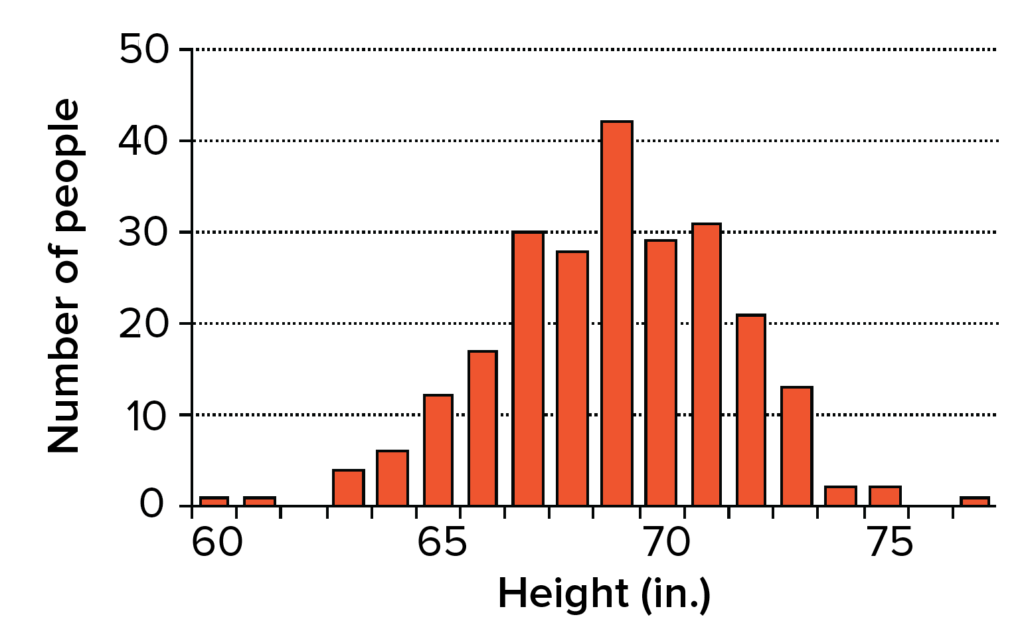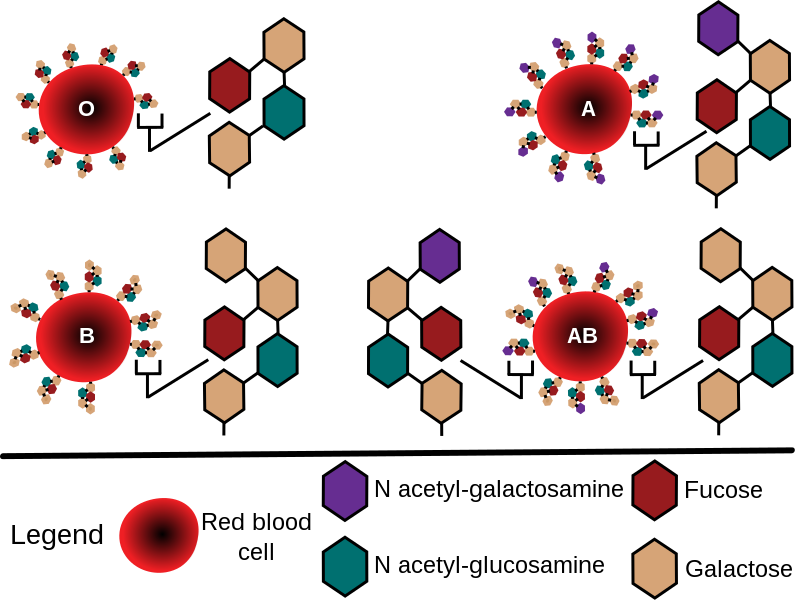OCR Specification focus:
‘Explain the genetic basis of continuous and discontinuous variation, including the influence of the number of genes involved.’
Variation among individuals within a species arises through genetic and environmental factors. Understanding how continuous and discontinuous variation occur explains patterns of inheritance and phenotypic diversity.
Continuous and Discontinuous Variation
Phenotypic variation refers to the observable differences among individuals of the same species. These differences can be continuous or discontinuous, depending on how traits are expressed and inherited.
Continuous Variation
Continuous variation occurs when phenotypic traits show a range of values between two extremes, with no distinct categories.
Examples include height, body mass, and skin colour in humans.
Such traits are often influenced by many genes and environmental factors.
Polygenic inheritance: The inheritance of a characteristic controlled by two or more genes, each with an additive effect on the phenotype.
Continuous traits are quantitative, meaning they can be measured along a numerical scale. The resulting data typically form a normal distribution curve, with most individuals showing intermediate values and fewer at the extremes.

Histogram of heights for male high-school seniors, demonstrating continuous variation with a roughly normal distribution. Most individuals cluster around the mean height, with few at the extremes. This visual reinforces that polygenic traits produce quantitative ranges. Source.
Genetic Basis of Continuous Variation
Continuous traits arise from the combined effect of multiple genes (polygenes). Each contributing allele has a small, additive impact on the final phenotype. For instance, in human height, alleles at several loci contribute to overall stature, and the more “tall” alleles inherited, the taller the individual.
Key genetic features include:
Additive effects: Each allele adds to the overall trait value.
No dominance: Alleles contribute equally; heterozygotes show intermediate phenotypes.
Cumulative action: The interaction of multiple genes produces a smooth range of variation.
Environmental influences, such as nutrition or health, can modify gene expression, further broadening the phenotypic range.
Phenotypic plasticity: The ability of an organism to alter its phenotype in response to environmental conditions.
Role of the Environment
Environmental factors play a significant role in continuous variation by affecting gene expression and trait development. Examples include:
Nutrition influencing height and body mass.
Sunlight exposure affecting skin pigmentation.
Exercise shaping muscle mass.
The interaction between genes and environment creates a wide phenotypic spectrum, demonstrating that genetic potential can be expressed differently depending on conditions.
Discontinuous Variation
In contrast, discontinuous variation shows distinct, non-overlapping categories. Each individual fits clearly into one of a limited number of phenotypic classes.
Examples include blood groups (A, B, AB, O) and pea flower colour (purple or white).

The ABO blood group system shows discrete phenotypic classes (A, B, AB, O) determined by allelic combinations at a single locus. Such monogenic traits display discontinuous variation with no intermediates. Extra biochemical epitope detail is depicted but not required by the syllabus. Source.
These traits are typically controlled by a single gene locus or a small number of genes, often with dominant and recessive alleles. Environmental influences have little or no effect on the phenotype.
Monogenic inheritance: The inheritance of a trait determined by a single gene with two or more alleles.
In discontinuous variation, phenotypes are qualitative, not measurable on a numerical scale. The resulting data form discrete categories, rather than a continuous range.
Genetic Basis of Discontinuous Variation
Key genetic principles include:
Single-gene control: Each phenotype determined by one gene locus.
Dominance and recessiveness: Allelic interactions determine which phenotype is expressed.
No additive effect: One allele may completely mask the other’s effect.
Little environmental influence: Phenotype is largely determined genetically.
Examples of genetic mechanisms include:
The ABO blood group system, where different combinations of alleles at one locus determine blood type.
The pea plant flower colour, determined by a single gene affecting pigment production.
Comparing Continuous and Discontinuous Variation
Both types of variation contribute to overall diversity within a species, but they differ in how phenotypes are distributed and influenced.
Continuous variation:
Controlled by many genes (polygenic).
Additive gene effects create a smooth gradient of phenotypes.
Environmental influence is significant.
Produces quantitative data forming a normal distribution.
Discontinuous variation:
Controlled by one or few genes (monogenic).
Clear-cut categories without intermediates.
Minimal environmental influence.
Produces qualitative data with distinct classes.
Visual Representation
Continuous variation produces a bell-shaped curve when data are plotted, reflecting a normal distribution. Most individuals cluster around the mean value, while few occupy the extremes.
Discontinuous variation, however, appears as separate bars on a graph, representing discrete categories with no intermediates between them.
Importance in Genetics and Evolution
Understanding these two forms of variation helps explain inheritance patterns and evolutionary processes:
Continuous variation provides material for natural selection to act upon gradually, leading to evolutionary adaptation over time.
Discontinuous variation may lead to sudden changes in populations if one phenotype provides a significant advantage.
Influence of Gene Number
The number of genes involved directly determines whether variation is continuous or discontinuous:
Traits controlled by a single gene produce discontinuous variation.
Traits controlled by many genes (polygenic) result in continuous variation.
Intermediate cases can occur when a few genes influence a trait, creating a limited range of phenotypic categories — a bridge between the two extremes.
Key Points Summary
Continuous variation arises from polygenic inheritance and environmental interaction.
Discontinuous variation results from monogenic inheritance with distinct phenotypic classes.
The degree of genetic control determines the pattern of variation observed.
Both forms contribute to phenotypic diversity, essential for evolution and adaptation.
FAQ
Environmental factors can influence gene expression through changes in resource availability and exposure conditions.
For example:
Nutrition affects the availability of energy and amino acids necessary for growth, impacting height.
Sunlight exposure influences melanin production in the skin, altering pigmentation.
Health and disease during development can affect growth rates.
These effects modify the potential outcome of genetic instructions, demonstrating gene–environment interaction and contributing to the continuous range of phenotypes seen in polygenic traits.
When many genes contribute small additive effects to a phenotype, their combined influence tends to balance around a mean value.
Most individuals inherit a mix of alleles producing intermediate phenotypes, while few inherit extreme combinations.
This results in a bell-shaped curve, where:
The peak represents the average phenotype.
The tails represent rare combinations of alleles leading to extreme phenotypes.
This pattern is characteristic of continuous variation in large populations.
In rare cases, environmental factors or modifier genes can blur distinctions between phenotypes.
For instance, a gene influencing pigment production might have its effect modified by temperature, leading to a gradient of colour intensity rather than distinct categories.
However, true continuous variation typically requires multiple genes acting together; a single-gene trait may only mimic continuity when environmental modulation is strong.
Mutations create new alleles, introducing genetic diversity.
In polygenic traits, small mutations across many loci can subtly shift phenotypes, widening the continuous range.
In monogenic traits, a mutation may produce an entirely new category (for example, a new flower colour), creating additional discontinuous variation.
Thus, the same process—mutation—can influence both types of variation, depending on the number of genes involved and the scale of effect of the mutation.
Continuous traits provide a spectrum of phenotypes, allowing gradual, measurable changes in response to environmental pressures.
Natural selection can act on small differences—such as slightly greater height, speed, or enzyme efficiency—favouring individuals with advantageous combinations of alleles.
This enables directional or stabilising selection, leading to adaptation over time.
Discontinuous traits, being categorical, typically change only when allele frequencies shift dramatically within a population.
Practice Questions
Question 1 (2 marks)
Explain why height in humans shows continuous variation.
Mark Scheme
(1 mark) Height is controlled by many genes (polygenic inheritance).
(1 mark) Each gene has an additive effect and the phenotype is influenced by environmental factors such as nutrition.
Question 2 (5 marks)
Compare and contrast continuous and discontinuous variation in organisms, using appropriate examples.
Mark Scheme
(1 mark) Continuous variation shows a range of phenotypes between two extremes, with no distinct categories.
(1 mark) Discontinuous variation has distinct, separate categories with no intermediates.
(1 mark) Continuous variation is usually controlled by many genes (polygenic), while discontinuous variation is typically controlled by one gene (monogenic).
(1 mark) Continuous variation is influenced by environmental factors, whereas discontinuous variation is largely unaffected by the environment.
(1 mark) Suitable examples: height or body mass for continuous; blood group or pea flower colour for discontinuous. (Any two valid examples earn the mark.)

